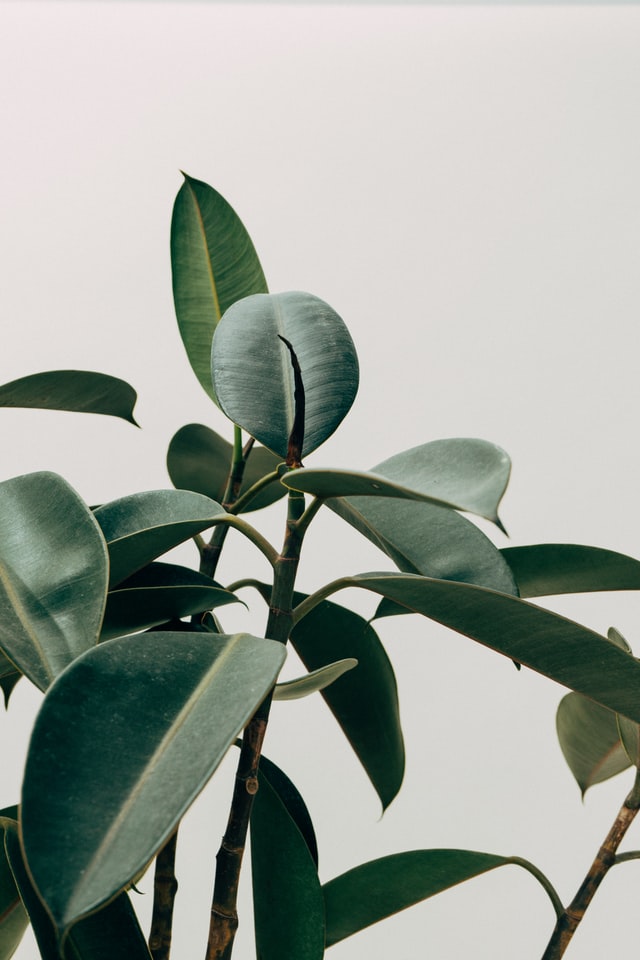The Variegated Rubber Plant or ruby rubber plant has become a popular fixture in plant enthusiast’s homes. It is officially known as the ‘Ficus Elastica Tineke’. This plant is part of the rubber tree family. However, it differs from most rubber plant due to its beautifully colored leaves.
The original rubber trees have large, dark green leaves. However, the variegated rubber plant is much more unique. These trees may appear red, green, yellow, or cream in color.
Evidently, the ruby rubber plant has become one of the most photographed plants of the year. It is simply photogenic in nature. They vary in sizes as well. Some are small enough to fit on your desk, while others can reach the ceiling.
How do Plants Become Variegated?
‘Variegated’ can simply be defined as differing in color. This is especially true when the colors appear patchy or inconsistent. These plants are typically harder to care for, but very beautiful nonetheless.
The plants variegation can occur due to two things. Firstly, it could be genetic. This is when the color change is stable. You can predict how the plant will appear based off the two parent plants. This is the most common way to create variegated plants.
The second way is called chimeric. This is when the plants variegation occurs randomly. This also results in a distinctive pattern.
Taking care of variegated plants can be a little more difficult than traditional ones. However, it just takes patience and a willingness to learn. In this article we are going to cover the important aspects of caring for a variegated rubber plant.
How to Water Your Variegated Rubber Plant
This plant can be water sensitive. Therefore, it is important to ensure that your variegated rubber plant is ready for water each time you go to water. Check that the top of the soil is dry (1-2 inches). Only water your ruby rubber plant once you’ve ensured that it is in need of it.
Your plant must be kept in a pot that is able to drain. You must thoroughly water your plant to the point that it is leaking out of the bottom. This next tip can get tricky: ensure that you don’t water it too much. Avoid watering the leaves and ensure that your plant is not actually sitting in excess water.
How much you water this plant is dependent on what season it is. Most people tend to water their variegated rubber plant every 5-7 days in the summer. However, it needs less watering in the winter. They can be watered every 10-14 days during the winter season.
How Much Sunlight Does my Ruby Rubber Plant Need?
Choosing the perfect spot to keep your precious plant can be a daunting task. There are many things to consider. Hopefully, this guide will allow you to pick the best-suited choice in your home or office.
The variegated rubber plant flourishes in spots that are well-lit. However, it is important to make sure that there is no direct sunlight. The leaves of this plant are highly sensitive. Therefore, placing this plant under direct sunlight can cause the leaves to burn.
You must also make sure that you’re not placing the plant in shade. This could cause the plant to lose the beautiful colors it possesses. It will appear to be less variegated.
All of this information can be a bit confusing. Place the plant in a sunny spot. But make sure there is a curtain that can prevent the sunlight from directly hitting the leaves of the plant. Remember that if the plant begins to droop or lose color it needs more light.
Does my Variegated Rubber Plant Like Humidity?
This type of plant loves humidity. Needless to say, it thrives when there is a lot of vapor in the air. This maintains the texture of the leaves. Furthermore, it actually prevents them from drying out. Plant owners can purchase a humidifier to keep the plant looking and feeling its best.
What About Feeding?
The variegated rubber plant doesn’t actually need to be fed. It’s a lot easier to overfeed this plant than one may think. Dried up leaves is the end result. This is due to fertilizer burn. Therefore, it may be better to avoid feeding this plant altogether.
Are These Plants Toxic to Animals?
This is not the best plant to keep around pets. They can be a little toxic by nature. However, many animals tend to avoid them straight away. This is because their leaves have an unpleasant rubbery texture.
The leaves of the plants excrete a milky sap when removed. This sap can cause irritation. Furthermore, ingesting this plant causes intestinal issues. Therefore, it is best if they are kept out of the reach of animals and small children.
Interesting Facts About the Variegated Rubber Plant
There is no doubt that this is one of the most interesting houseplants one can own. Here are some interesting facts about this plant:
- The paler parts of the ruby rubber plant are not able to photosynthesize. Although this is what makes it beautiful, it also makes it more difficult to care for. The plant must receive enough sunlight to compensate for this.
- These plants are not self supporting. This means that the larger they grow, the more unstable. They start drooping once they reach a certain height. You can easily hold them upright by using bamboo or wooden dowels.
- These plants are known to grow quickly. They can grow up to 24 inches in a single season!
- The variegated rubber plant consumes its own soil. This means that you should keep a supply of soil on hand for when it becomes low.
Purchasing a Variegated Rubber Plant
Purchasing this plant can prove to be a difficult feat. They are highly uncommon due to their mutation. However, this makes them even more sought-after. Some local specialty stores might carry them if you’re lucky.
The internet is the best place to buy rare plants. There are many rare plant stores online that may be able to ship to your house. Keep in mind that this can get expensive. However, the beauty of this plant makes it worth it.






